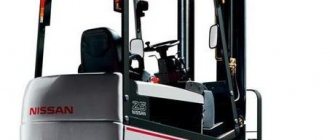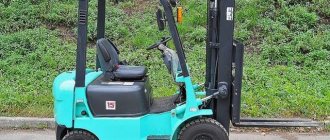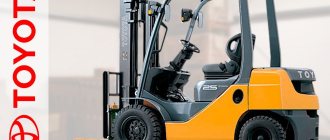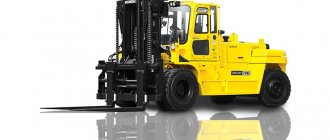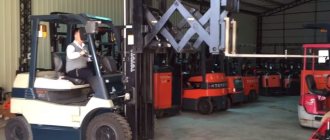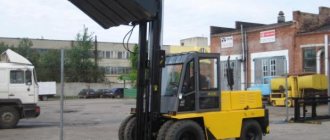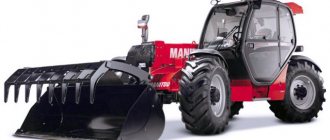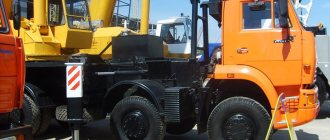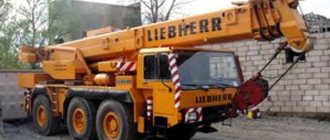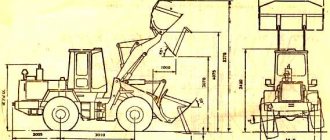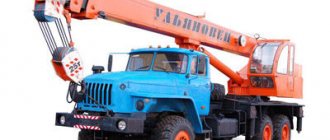Forklift (in English forklift truck) is a type of warehouse equipment whose purpose is unloading and loading, as well as moving and stacking cargo.
Read: Operating forklifts in winter. Useful tips
When choosing a forklift, you need to consider a number of factors. Today we will touch on one of them - the technical characteristics of the machine itself, the optimal combination of which can be found by formulating the intended functions of the loader and its operating conditions.
Photo source: cartrade-r.ru Gross weight is the weight of the loaded loader, as well as the weight of the operator and cargo
Review of the best models
The rating of the best models includes Japanese and Korean brands, as well as some Russian-made units.
2 tons
The best forklift with a lifting capacity of 2 tons is the Goodsense FD20B. Specifications:
| Motor | 490BPG/С240PKJ |
| engine's type | Diesel |
| Number of cylinders | 4 |
| Number of forward gears | 1 |
| Number of reverse gears | 1 |
| Maximum speed, km/h | 19 |
| Ground clearance distance, cm | 12 |
| Wheelbase, cm | 160 |
| Fuel tank volume, l | 70 |
| Turning radius, cm | 217 |
| Weight, kg | 3200 |
| Mast | Yes |
| Maximum torque, Nm | 148 |
| Load center of gravity, cm | 50 |
| Maximum lifting height, cm | 300 |
Advantages of this forklift model:
- High level of productivity.
- Safe and reliable design.
- Small dimensions.
- Low location of the anti-slip step.
- Comfortable driver's seat.
- Good viewing angle and visibility in any lighting.
- The unit is equipped with a durable cover that provides additional operator protection.
- The mini loader can be used both outdoors and indoors.
3 tons
The Hyundai HD20 diesel loader with a load capacity of 3 tons and a lifting height of 3-6 m is designed for intensive work in cars, containers, trucks, in open and closed warehouses.
Technical indicators:
| Manufacturer country | South Korea |
| Motor | AG44 |
| engine's type | Diesel |
| Engine power, hp | 47 |
| Parking brake type | Manual |
| Mast tilt | 12° |
| Maximum speed, km/h | 21,8 |
| Ground clearance distance, cm | 12 |
| Wheelbase, cm | 16,25 |
| Wheels | Pneumatic |
| Turning radius, cm | 22,4 |
| Forklift weight, kg | 3420 |
| Mast | Yes |
| Dimensions, m | 3.6x1.2x2.14 |
| Load center of gravity, cm | 50 |
| Maximum lifting height, m | 6 |
Pros of the job:
- Powerful, all-wheel drive and reliable engine.
- High level of productivity.
- Economical service.
- Comfortable operator workplace.
- Clear and simple controls.
- The package includes a side grip and a roll grip.
- High level of maneuverability, which makes it possible to use the equipment in wagons, holds, and small warehouses.
5 tons
The best 5 ton diesel forklift is the Manitou MI50G. It is equipped with a gas engine and is designed for loading and unloading operations at indoor and outdoor production sites.
Technical indicators of this model of equipment with a lifting capacity of 5 tons:
| Motor model | PSI 4.3L |
| Number of cylinders | 4 |
| Engine power hp | 75 |
| Maximum speed, km/h | 25 |
| Ground clearance distance, cm | 37,5 |
| Track base, cm | 212,4 |
| Load center of gravity, cm | 60 |
| Maximum lifting height, cm | 370 |
| Wheels | Pneumatic |
| Engine cooling system | Yes |
| Front wheel track, cm | 162 |
| Rear wheel track, cm | 172 |
| Weight, kg | 7660 |
| Dimensions, m | 3.3x1.5x2 |
Advantages:
- Reduced level of harmful substances released into the atmosphere.
- Low fuel costs.
- Long working life.
- High level of productivity.
- Control panel with LCD display.
- Adjustable steering column.
- Heating in the driver's cabin and built-in lighting.
- Low noise level during operation, not exceeding 5 decibels.
10 tons
The best forklift with a lifting capacity of 10 tons is VP-05. It runs on the D-243 engine, which was developed during the Soviet era.
This equipment, based on Soviet developments, is produced by the Tver plant.
Technical parameters of VP-05:
- engine model - D-243;
- maximum pressure limit in the hydraulic system - 18 MPa;
- wheelbase - 22 cm;
- thrust - 28 kN;
- the loader weighs 7,800 kg;
- number of cylinders - 4;
- fuel tank volume - 4.75 l;
- type of fuel used - diesel;
- average fuel consumption is 13.4 l/h.
Among the advantages are:
- High speed of load lifting.
- Good level of maneuverability.
- Economical fuel consumption.
- Easy controls.
- Minimum amount of emissions into the environment.
- An advanced hydraulic system that is responsible for both lifting capacity and control.
- The unit operates even at low temperatures (down to -40°C).
- The driver's cabin is heated.
- Low maintenance.
- Having spare parts readily available helps reduce downtime.
Simplex single section mast
The simplex mast has only one section, so it does not have side lifting cylinders, but only a central cylinder, which is both a freewheel cylinder and a main lift cylinder. Explicit representatives and owners of such masts are hydraulic stackers with a lifting height of 1.6 m.
How to Operate a Forklift
Driving this type of forklift differs from driving a car in that the movement is carried out by the rear wheels.
There are several rules for driving a forklift vehicle:
- It is prohibited to carry passengers in the cabin.
- Before starting work, you must ensure that the locking batteries, fuel tanks and their caps are securely fastened.
- During the execution of the task, the unit's load-carrying capacity restrictions must be observed.
- The forks should be positioned as far below the load as possible. The fork spacing must be correct to ensure load support.
- You cannot transport goods that are poorly folded or packaged.
- If visibility is lost due to the load, then you need to move in reverse.
- It is forbidden to make sharp turns and stops; movement must be smooth.
- It is necessary to monitor the position of the wheels in relation to the edges of loading ramps, platforms and other vehicles.
- It is recommended to mark the work area with yellow lines.
- Before parking, you must move the control levers to the neutral position.
- It is prohibited to lift people on the forks of the forklift.
Selection criteria: what to look for when choosing
From our review you will learn what a forklift is and what types there are, and we will also consider in detail the following characteristics, knowledge of which affects the correct choice:
- engine types;
- load capacity;
- lift height;
- building height;
- fork size;
- number of wheels;
- tire type;
- transmission type;
- counterweight;
- optional equipment;
- safety;
- price.
Basic faults, maintenance and repairs
Operators may encounter the following forklift problems:
- Breakdown of the working mechanism.
- Engine or transmission failure.
- Malfunctions of the brake, hydraulic or steering systems.
In order to avoid breakdowns, it is necessary to carry out scheduled maintenance of the unit in accordance with the operating manual.
Repair of forklifts can be carried out as follows:
- If the working mechanism fails, you need to inspect it, lubricate the bearings, check the condition of the tension chains, the movable frame booms and the integrity of all links.
- If the engine or transmission fails, it is necessary to replace the fuel filters and check the oil level. Do not allow the oil fluid to overheat.
- If the breakdown is in the brake or steering system, you should check the brake fluid level and make sure that there is no leak in the brake master cylinder. The steering rack needs to be inspected.
Mast replacement
Practice shows that when buying a forklift, customers try to save money and buy forklifts and electric forklifts with a standard mast, since it is cheaper.
Then they move to another warehouse, where the racks are already one tier higher. So what should I do? Buy a new forklift? But the existing one is satisfactory, except for the lifting height. Change the mast? But who will help? "Sklad.ru" replaces the mast or replaces the loader in its own Service Center. Send a request or call 8-800-250-83-33
Terms of use
To ensure reliable and uninterrupted operation, reduce depreciation and increase the service life of components and components when operating forklifts, it is important to follow certain rules and regulations.
For example, the Operating Instructions for a forklift require mandatory compliance with the following points:
- 1.Operator qualifications.
Skilled worker
Loading and unloading operations must be carried out by an employee who has the appropriate skills and has been trained to operate this type of equipment.
- 2.Use of special work clothes.
It must have protective properties. The operator's kit must include: a helmet, safety shoes and a jacket with reflective elements. When working, clothing should not cling to the elements and parts of the loader.
- 3.Preliminary inspection.
Before loading and unloading operations begin, the operator must inspect the vehicle to identify possible problems and malfunctions. If they are detected, the loader cannot be allowed to operate.
- 4.Launch.
Access to the cabin is via steps supported by handrails.
The operator must be fastened in it .
Work can only begin in a seated position, unlike crawler loaders.
Load capacity
This is the first thing to think about. At first glance, it may seem that there is nothing complicated in this issue, and to make a final decision regarding the forklift model, it is enough to read the technical documentation. In practice, everything is more complicated. If only for the reason that lifting capacity can be nominal and residual: nominal lifting capacity is the maximum permissible weight of cargo that a forklift can lift. Residual lifting capacity is the weight of a load that can be lifted to a certain height without losing the stability of the forklift. More lifting height means less residual load capacity. The higher the lifting capacity of a forklift, the more expensive it is. Therefore, try to determine as clearly as possible the operating parameters of warehouse equipment and the cargo being processed before purchasing.
Engine
The main element of any machine, the right choice guarantees trouble-free operation of the equipment and saves the budget from unplanned expenses.
First, you should clearly determine where the loader will be used. If we are talking about working only indoors, the best solution would be an electric motor (especially if the work involves loading such categories of goods as food, medicines, etc.).
Electric forklifts are economical to operate and maintain and are highly reliable. The standard acid battery of an electric forklift is designed for continuous operation within 5-7 hours; if this operating time per shift is not enough, then it is necessary to purchase an additional battery. It should be remembered that to charge acid traction batteries you will need a specially equipped charging room with ventilation.
The diesel engine, on the contrary, is designed for operation on the street or under a canopy; it has the longest service life, is unpretentious in operation, and economical, but, unfortunately, its exhaust gases are toxic and dangerous for personnel when working in a confined space.
A gasoline engine will be an intermediate option; it makes sense to immediately equip it with gas equipment, which will make it possible to work both in a warehouse (with good ventilation) and on the street. This engine option will be cheaper than an electric one and will not create the need to equip a warehouse with a charging room, which is important for small enterprises.
The next important question regarding the choice of internal combustion engine will be the manufacturer. How not to make a mistake and not overpay? Let's explain. If the forklift will be used in a standard eight-hour shift or less, then you can safely save money and opt for a diesel engine version from a Chinese manufacturer, for example Xinchai 485, 490, Weichai WP4.1 and LuoTuo LR4B3. They are reliable, have good power and will more than return the money invested. For enterprises with a round-the-clock operation cycle, we recommend purchasing configurations with Japanese engines Isuzu C490, Mitsubishi S4S, S6S. With long operating hours, the Japanese engine shows itself to be more efficient and cheaper to operate due to its longer time between failures. Definitely choose a gasoline loader with a Japanese internal combustion engine (Nissan, Kubota, etc.), the quality of gasoline engines from Chinese manufacturers leaves much to be desired.
A few words about attachments
The forklift comes standard with forks. But to get a truly functional lifting and transport machine, this is not enough. We recommend that you think in advance about equipping your equipment with attachments and consult regarding their compatibility.
All attachments are divided into 3 large groups:
- devices to improve the convenience of working with forks (for example, side shifters and positioners);
- devices that expand the capabilities of equipment (load pushers, fork extensions and tippers, clamping parts, carriage rotation mechanisms);
- mechanisms for solving new problems (mechanical grippers for bales, barrels and paper rolls, buckets for bulk materials, mandrels, etc.).
Before connecting the attachments, you need to expand the capabilities of the hydraulic distributor, separate the hoses, and perform other manipulations. Next, it is important to make sure that the new devices work correctly.
